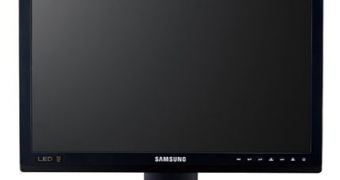At the second plugtest organized by the Video Electronics Standards Association, VESA for short, for the new DisplayPort version 1.1 which tested the interoperability of hardware parts made by different manufacturers, among the companies that presented product featuring the new interface there was also Samsung.
Just like AMD which presented the first native supporting DisplayPort 1.1graphics processing unit, Samsung was the first company to present a liquid crystal display panel, LCD for short, that is compliant with the same new standard. The DisplayPort version 1.1 is intended as a replacement for DVI, LVDS and in the near future VGA. Samsung's LCD panel, thanks to its DisplayPort support, can receive a total data transfer rate of 10.8Gbps. The high data speed of this standard allows the use of higher resolutions, up to 2560x1600 and using a more advanced color palette. Instead of two DVI links the Samsung DisplayPort compliant LCD requires a single interface and cable.
The new LCD panel was developed and built by Samsung in a joint effort with the US firm Genesis Microchip. It uses a new four-lane, 2.7Gbps/lane interface chip that can process up to 2560x1600 pixels of graphics data at a color depth of 10 bits, which translates into 1.07 billion colors. Without the DisplayPort interface such high resolutions and depth of color would require the presence of at least three DVI or four LVDS interface chips. "We are pleased to be the first LCD manufacturer in the world to create a panel with a DisplayPort interface," said Brian Berkeley, Vice President, Samsung LCD Business, who is leading the company's DisplayPort development efforts, who was cited by the news site Bi-Me.
Apart from the new standard for graphics processing, the Samsung LCD comes equipped with the Super Patterned Vertical Alignment (S-PVA for short) technology that allows for wider than normal viewing angles and higher brightness. The mass production of the 30 inch LCD panel is not due to start until the first months of the next year.

 14 DAY TRIAL //
14 DAY TRIAL //